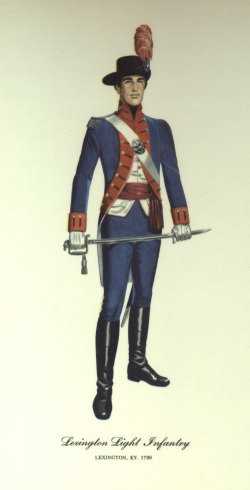
Light Infantry Uniform circa 1789 - Lexington Light Infantry, Lexington Ky 1789
Encouraged by the defeat of St. Clair, the Indians and their British backers struck hard at Kentucky. At times as many as two dozen people were slain at a single settlement.
Simon Kenton, an early commander of the Kentucky Militia, helped develop a more sophisticated Militia in Northern Kentucky when, in 1786, he trained spies and scouts, appointed commanders and signal corps, and procured arms and ammunition for his Company, which then was known as the Mason County Minutemen. For eight years these Minutemen covered all of Northern Kentucky from April until November, the months most subject to Indian depredation. It was during this same period that the militiamen of Kentucky came to be known as "The Limestone Volunteers".
The activities of these volunteers were not limited to their home state but often extended beyond Kentucky into Ohio and Indiana in pursuit of Indian raiding parties. Because of the serious nature of these interstate raids, President Washington ordered several of the National Militia to active duty for three-month tours to aid the frontier states to ward off the British-Indian threat. This, of course, caused various complications to arise. In order to continue such coordinated efforts, the Kentucky Board of War was established in 1791, whose duty it was to call out the Kentucky Militia in the service of the United States whenever necessary. It was due to these combined efforts of the Kentucky Militia and Federal troops that, during the next two years, the threat of Indian attacks was reduced to a minimum. Some 1,500 Kentucky Militiamen led by future Adjutant General and Governor John Adair, and future Governor Charles Scott, comprised half of the combined forces under General "Mad" Anthony Wayne to defeat a force of 2,000 Indians and 70 Canadians in August 1794, at the Battle of Fallen Timbers, Ohio.
Also in 1794, Colonel William Whitley and the Southern Kentucky Militia, fighting alongside the Tennessee Territorial Militia, defeated the East Tennessee band of Chickamauga Indians. Following these two victories, treaties were signed, ending the Indian threat in the central Bluegrass and Southern Kentucky. However, it did not stop, but the scope and threat of attack in Western Kentucky were greatly diminished.
In 1811, General William Henry Harrison, a former Kentucky Militia officer serving as governor of the Indiana Territory, led a 1,000-man force into the Northwest to attack the Tecumseh alliance. In this force were 100 members of the Kentucky Militia under Colonel Daviess, who later lost his life in the defeat of the Indians at Tippecanoe in a victory that forever rid Kentucky of the Indian menace.